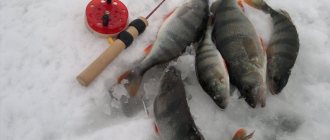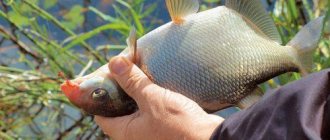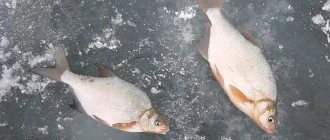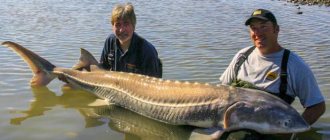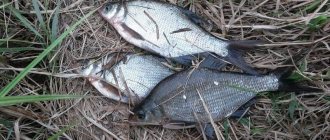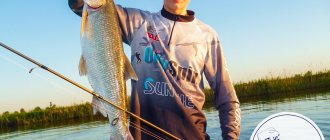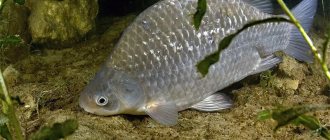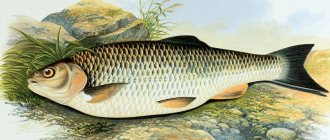Bream is a common fish: it inhabits almost all more or less large rivers and reservoirs of Central and Southern Russia. Bream is not of great commercial importance, because it is quite bony, but hunters are not afraid to get a trophy specimen. Interestingly, despite the wide habitat and large population of this representative of the ichthyofauna, bream fishing remains an art for select, especially seasoned fishermen.
Catching this representative of the carp family requires special care in the selection of equipment, knowledge of the preferences of the fish and the characteristics of its behavior, long-term and intelligent hooking - in a word, a delicate approach that can only be gained through many years of experience. Well, let’s try to outwit the bream together: we have the theoretical foundations, and you have constant practice on the pond!
Seasonal fishing features
Bream, like any representative of the ichthyofauna, is very sensitive to external conditions. His life is subject to a strict schedule, which is dictated by both the time of year and the conditions of the reservoir. So, let's look at the graph of seasonal activity of bream:
- Spring . This flowering time is considered the best time to catch bream. It becomes active after the last ice - fishing in March can be very productive. Then there follows a slight decrease in the intensity of the bite, giving way to an active pre-spawning feast. Fish spawn from April to June. The hotter the year, the faster the spawning session ends, when the bream is not at all interested in feeding. After spawning, the fish rests a little, then gives out another wave of zhora, which gradually subsides in the first month of summer. It bites on everything, including artificial bait.
- Summer . With the onset of heat, bream becomes capricious, so catching it in the summer is quite difficult. Hunting for it turns into fun for the most patient and experienced fishermen. Selecting bait turns into a kind of quest: it is not clear what the bream in a particular reservoir will prefer at the moment, a dung worm or a liquid mastyr. You will also have to tinker with finding a promising place - the heat drives the bream into deep holes, from which it emerges only in search of food. And this is mainly at night and early morning - catching this fish during the day is not very promising.
- Autumn . In the last weeks of summer and early autumn, the bite becomes more confident and stable. The ideal time for bream fishing is the Indian summer period, days with stable pressure, light drizzle and breeze. Bream bite especially well in September, on sun-warmed shallows. At this time, it is better not to approach it with plant baits: the fish is actively stocking up on protein for the winter. With the onset of frost, the bream moves to the wintering pits and freezes.
- Winter . Like most representatives of large carp species, bream is practically inactive in winter: fishing is effective only during periods of thaw. Bloodworms and jigs are in favor, but you need to take into account that the chances of catching a truly worthy specimen are minimal. At the exit from the wintering pits, it is mainly the bream that pecks, while trophy specimens fall into suspended animation, stand motionless and do not feed. The real gluttony begins after the last ice, when the fish strives to fatten up after a forced hunger strike.
Features of choosing bait by season
The choice of bait depends greatly on the time of year. In cold water, vegetation is poorly developed, so in spring and autumn, fish are forced to feed on aquatic insects and invertebrates. As the water warms, aquatic vegetation begins to develop rapidly and by the beginning of summer it makes up a significant part of the bream’s diet. However, large specimens prefer protein-rich animal food, as it allows them to quickly accumulate the necessary fat reserves. For fishing to be successful, the angler must understand what bait to use depending on the time of year.
Bait in spring
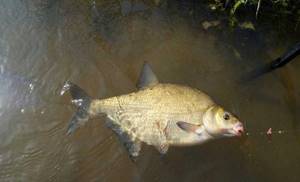
A dung worm or crawler is the best bait for bream in the spring. This is due to the fact that most flowing reservoirs experience high water in the spring. The rapid flow of water washes away the earthen banks, and worms fall into the water along with the earth. The fish quickly gets used to such food and prefers the worm to other baits. Active fishing of bream on a worm continues until the end of the flood.
In mid-spring, maggots show good results. Closer to summer, fish begin to pay attention to pearl barley and corn.
Bait for bream in summer
In summer, plant baits work better. In June, fish prefer to bite on the following types of bait:
- Hercules;
- peas;
- bread;
- pearl barley
In July, semolina dough flavored with sweet flavors begins to work well. At the end of the summer season, the fish prefer maggots.
Bait for bream in autumn
Dung worms and maggots are the most catchy baits for bream in the fall. At the beginning of autumn, the fish still pays attention to plant baits, but by the middle of the autumn season it completely switches to animal food, trying to accumulate more fat before wintering.
Bait in winter
Bloodworms are the main bait for bream in winter. In addition to bloodworms, fish bite on worms and maggots, as well as semolina dough mixed with beef blood.
When is the best time to go fishing?
In the spring, bream can be caught around the clock, without particularly worrying about the choice of bait. During the day, fishing is most promising: bream comes out to the sun-warmed shallows, so you can catch it at shallow depths, even with a float rod. This is important, since during the period of spawning restrictions this is often the only permitted method of fishing.
This bait provides a rich catch even with a bad bite! Read more In summer, daytime fishing is not very promising. True, if there is no extreme heat, a good trophy can be obtained at the exit from a deep hole, from a boat, or with well-placed bottom tackle. It is better to shift the fishing period to night or early morning: at this time, feeding trophy specimens come closer to the shore.
In September, catching bream is equally likely throughout the day: it actively feeds in the shallows and near the shore. Then the bite becomes unpredictable: periods of activity are replaced by complete calm.
The ideal weather for catching bream in open water is a stable pressure that lasts for several days, short warm rain, a light wind raising ripples or a low wave. Sometimes bream demonstrate incredible gluttony on the eve of a thunderstorm, but such periods, as a rule, are short-lived.
What to fish with
The choice of gear with which you can catch bream in the summer depends entirely on the reservoir. In this sense, two categories can be considered:
- where shore fishing is possible;
- where a floating device is required.
On the lake and small river
We include in this category water bodies where fishing from the shore is possible and in order to catch bream you do not need to enter the water in a boat or on a motorboat. On a river of small width or a small lake, several gear options are possible:
- Float rods of various modifications. The choice of a particular one depends on the distance to the catching point and the presence of current strength.
- Bottom fishing rods, including feeder. Here, too, the choice of rod class depends on the distance to the fishing spot: the further, the more powerful.
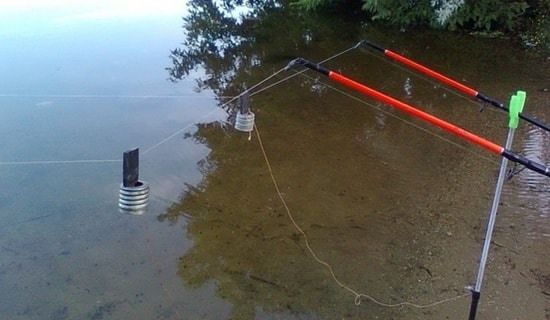
Bite alarms are obligatory elements of bottom gear.
On a large river and reservoir
On large rivers, such as the Volga, Dnieper, Don, Kama and others, in the summer it is sometimes impossible to reach the catchable edge from the shore, so you have to use swimming devices and catch bream from them. The exception is, already mentioned above, night fishing, when the fish rises closer to the shore.
You can fish from a boat using the following types of gear:
- float rod;
- small feeder or donku;
- ring;
- jar;
- access
Attention! The last three gear from the list are applicable exclusively on bodies of water with current.
Next, we’ll look at how to equip and fish with the listed gear in more detail.
Where to look for bream

In small bodies of water with stagnant water and a silted bottom, you don’t have to look for bream: the bait will catch rotan or the ubiquitous crucian carp. You should not try to catch it in a fast-moving small river with a strong current. And in general, the bream tries to avoid areas where there is even a current of moderate strength: its body shape is very unsuitable for fighting the water flow.
Bream is a schooling fish, loving to settle down, peace and quiet in the company of its own kind. Numerous schools of bream can be found in large clear lakes, reservoirs with running water, and on large deep rivers in places where the flow is slow. Bream likes to stand in pools formed at the confluence of tributaries, deep channel holes, reaches between riffles and near river bends - in short, where the flow slows down significantly. On the lake it stands in holes at depths of over 3 meters.
Unfortunately, it is becoming less and less possible to effectively catch bream from the shore. Shy fish moves far away, choosing the deepest areas. You can catch it only on the food trail to the feeding place (edges, silty and clayey areas of the bottom, shell rock) or directly “in the canteen”. To do this, you should carefully study the topography and nature of the bottom using a weight or a marker float. There are also special coastal echo sounders that show pictures of underwater life at the location where the sensor is cast.
The ideal option is a boat, an echo sounder and a navigator. We move around the water area, conduct monitoring, and pinpoint promising places. You can visually detect even fish standing in pits, and by the size of the bubble you can determine its expected size. The place of eating is rarely located more than 200 meters from the main “apartment” of these representatives of the ichthyofauna - bream is very lazy, moving only when necessary (searching for food or breeding) and over short distances.
There is one sign that allows you to identify the bream table almost accurately. Air bubbles rise up there: the bream collect zebra mussels, larvae and other benthic small items from the bottom.
The best vegetable baits for bream
Vegetable baits are used in the warm season, when the water warms up above 15 degrees. The advantage of plant-based baits is that they can be prepared from products available at home. The best vegetable baits for fishing bream are:
- pearl barley;
- Hercules;
- semolina dough;
- peas;
- corn.
Pearl barley is a bait that holds securely on a hook, so it is often used when catching bream using bottom gear. Small fish do not like this bait, which makes pearl barley a good bait for catching trophy bream.
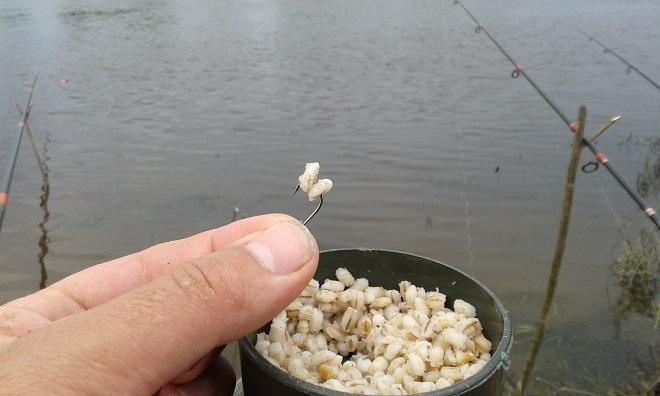
Fishermen often make a mistake when preparing cereals: pouring a large pan of water and pouring a handful of pearl barley into it - this is wrong. The cereal should be boiled in a small amount of water, stirring constantly and making sure that the contents of the pan do not burn, since even a faint burning smell can alert the fish. Cooking time is 50 minutes (after water boils). By the end of cooking, the liquid in which the pearl barley is cooked should be a mucous substance that generously covers the cooked grains. The grain prepared in this way, once in the water, will form a cloud of turbidity around itself, which additionally attracts fish.
The taste buds of bream are located on the outer side of the lips and before swallowing the bait, the fish tastes it, so during the cooking process a little sugar or honey is added to the barley. To enhance the attractive effect, boiled grains can be rolled in powdered milk or baby food. Place 2–3 large grains on the hook. The optimal hook number is 8–4.
Hercules is an effective bait for bream in the summer season, which is useful when the fish feeds not from the bottom, but in the water column. The process of preparing rolled oats consists of three stages:
- oatmeal is poured into a fine-mesh colander;
- scalded with boiling water;
- pour onto a dry cloth to dry.
After scalding, the rolled oats become viscous on the outside and dry on the inside, which allows them to stay securely on the hook and at the same time increases their buoyancy. The grain attached to the hook slowly sinks into the water column and provokes the bream to bite. For fishing with Hercules, light hooks are used to ensure a slow fall of the bait.
Semolina dough - bream loves this bait in mid-summer, when the water temperature exceeds 20 degrees. The attachment is mixed using semolina and water. During the kneading process, honey or sugar syrup is added to the dough. To give the bait an attractive aroma, add a little cinnamon powder. The viscosity of the dough can vary and depends on the strength of the current at the fishing site. The stronger the current, the more viscous the nozzle should be. For such plant baits, hooks are used that are equipped with a small spiral attached to the shank. This spiral prevents the bait from flying off during fishing.

Peas - used as bait, and also as bait for bream in the summer. After an hour and a half of cooking, the dried peas become soft and can be easily placed on the hook. Some anglers use pea dough for bream fishing, which is prepared as follows:
- peas are cooked for 2 hours;
- cools down;
- grinds into porridge;
- mixed with a small amount of flour;
- knead in your hands until a homogeneous mass is obtained.
On the shore of the reservoir, a ball with a diameter of 1–1.5 cm is formed from the resulting dough, which is placed on a hook No. 8–4.
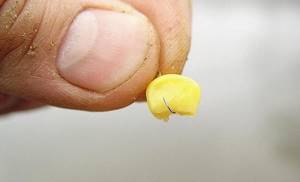
Corn – This bait helps weed out small fish and is a favorite of bream. For fishing, it is preferable to use canned sweet corn. Before attaching to the hook, the grain must be slightly mashed so that it produces juice that attracts fish with its aroma. 1-3 grains of corn are placed on hook No. 6-2. The liquid contained in the jar can be added to the bait mixture.
Bream baits
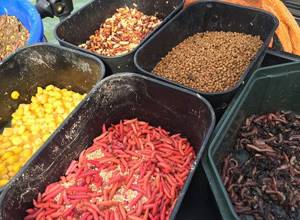
Bream is primarily a carnivorous fish. He prefers food of animal origin: zebra mussel, bloodworms, larvae of other mosquitoes, fallen and drowned insects - in a word, everything swarming at the bottom and containing protein can attract his favorable attention.
During the spawning period, a peaceful representative of cyprinids turns into a real robber, eating not only caviar with appetite. However, bream can be successfully caught using plant and even artificial baits. Let's go through them in more detail:
- Animal bait . The undisputed and all-season leader in this category is the dung worm. Fragrant (from the point of view of the bream), appetizingly wriggling worms are placed on large hooks in bunches - this is an unmistakable option for any body of water and time of year. Bream loves maggots and bloodworms, and does not disdain small leeches, crayfish pulp, dried meat of river mollusks, and, in winter, mormysh.
- Plant attachments . Bream can also be successfully caught using plant baits, since when the water warms up significantly in the summer, it approaches staunch vegetarianism. Among vegetable attachments, the leading positions should be given to canned corn, steamed peas, wheat, oats, and star pasta. Young potatoes in pieces are good, dough in boilies and just like that, liquid mastyrka (sometimes it is spread on a hook with a match and even in standing water it lasts only 5-10 minutes). A universal option, if you don’t want to bother too much, is pearl barley, cooked until half cooked. You'll have to play with attractants, the main thing is not to overdo it.
- Artificial baits . Catching bream with artificial bait is usually more difficult than with natural bait. The choice of an artificial worm or maggot made from flavored “edible” silicone is to some extent justified when fishing in a river where the current animates the bait. Plastic imitations of plant baits, coupled with appropriate attractants, are relevant during the feeding period: the fish greedily devours everything offered, and there is simply no time to change the bait. During periods of pre-spawning hyperactivity, fishing with a spinner bait is effective: the bream turns into a predator and greedily attacks small fish. The tackle is a spinning rod, the spinner is small, the wiring is leisurely and uniform.
All kinds of combined baits also perform well. On one hook you can put pasta and grains, maggot and corn, dung beetle and pearl barley. Taking into account the dietary vagaries of bream, such combinations are justified.
Artificial bait
Whatever he doesn’t fall for. Recently, scented foam has become a very popular bait for fishing. The whole secret of fishing with foam is in the correct presentation of the bait. A necessary condition is the presence of a feeder with a short leash.
In June-July, bream is successfully caught using feeders and bottom fishing rods. Therefore, when fishing with foam, you should give preference to these gears.
When fishing, it is better to have foam plastic of different colors and smells with you, since it is not known what he will like on a particular day. His favorite flavors are garlic and corn.

How to choose bait for bream
Spring bait
To fish in reservoirs with a current, it is necessary to add viscosity ; for this, clay from the reservoir and pea flour are used. Fraction : small, but always with the addition of large pieces of live maggots and food bloodworms. Color : light Smell : coriander is the best option Additives to attract large fish: instant corn, crushed peas, scalded maggot
Summer baits
In the summer heat, many complain about a complete lack of bite , but this is not always true. Properly selected bait can attract the attention of bream even in the heat. June: worm, maggot, corn, peas, pasta. July: steamed barley, maggot worms in the form of sandwiches. August: bread, pasta, corn, maggot worm. Temporary decreases in temperature indicators will entail a return of bream to animal types of bait ; vegetable bait should be offered in hot weather.
Autumn lures
In the autumn, bream continue to be actively caught on the feeder; groundbait and bait, as before, should work in tandem in such gear. As the temperature drops, bream will again want “meat” baits. September: earthworm and dung worm, maggot, hominy, bread, steamed cereals. October: bloodworms, worms, less often maggots. November: maggots and bloodworms, plant-based baits will not work. It is important to understand that the bait used in crushed form must be added to the bait.
Winter lures
In winter, bait for bream is very important; it is more difficult for passive fish to attract attention . Therefore, the selection of bait should be approached very carefully. December: sandwiches made from pieces of worms, bloodworms and maggots, less often boiled peas are used. January: bloodworm, worm. February: worm, bloodworm, semolina, peas. You can experiment and try using the dough as bait; at the end of February, bream can respond well to this species.
Features of bait
There are no trifles in bream hunting: you need to prepare for the trip several days in advance. Ideally, active fishing for trophy specimens should not begin immediately upon arrival at the reservoir.
Without preliminary feeding, fishing is unpromising, and large bream should be baited several days before the start of the session. The bait for preliminary feeding and the bait for the main fishing are usually prepared according to the same recipe, because the bream needs to get used to the aroma and taste of the food.
Feeding is carried out several times a day, throwing food balls near the bream camp (preferably on a food trail or directly in the place of their constant feeding). If you have a boat and shallow depths, you can simplify the task: install stakes on which to hang bags of feed mixture.
Massive feeding is carried out before fishing and immediately during it, so that the bream constantly spins in the casting area. Bait balls the size of an apple are thrown between landings, when it is known for certain that frightened members of the flock have temporarily left the “canteen”.
The bait spot should be different in color from the surrounding bottom surface, so natural coloring fractions are often added to the mixture, for example, red loam or black soil (depending on the desired consistency, which is selected depending on the strength of the current).
The basis of the bait mixture can be a ready-made fraction, which can be purchased in the store. However, you can use millet and pearl barley porridge, steamed grain, sunflower and hemp cakes, and steamed peas. The addition of milk powder and breadcrumbs is justified. The main thing is to achieve a soft viscous consistency suitable for forming bait balls.
As attractants, store-bought compounds or natural additives are usually used: salt, sugar, honey, valerian, anise, cumin, coffee grounds.
Catching bream on a rocker
The bottom rig with a rocker is highly effective on bream. It is relevant not only in winter, but throughout the entire season.
What is
The equipment received its name due to its similarity with an arched wooden device - a rocker.
This method involves the use of two hooks, spaced apart at a certain distance. This placement of the bait eliminates the possibility of tangling and overlapping of the leashes with each other. loaded in the center of the rocker arm itself. For fishing in still water, a sinker of 2-3 grams . When fishing in the current, depending on the strength, from 10 grams . Hooks are used for bream and whitebait in sizes 10-12 .
This type of bottom equipment has its advantages :
- Possibility of catching bream in heavily silted areas of the reservoir.
- The tackle is unnoticeable to the eyes of the fish, the leashes are not pulled, and the prey does not feel resistance at the time of the bite.
- Thanks to two hooks, you can quickly decide on a catchable bait option.
- The bait always remains in the bream's field of vision.
- Ideal for catching large specimens that have a heightened sense of danger.
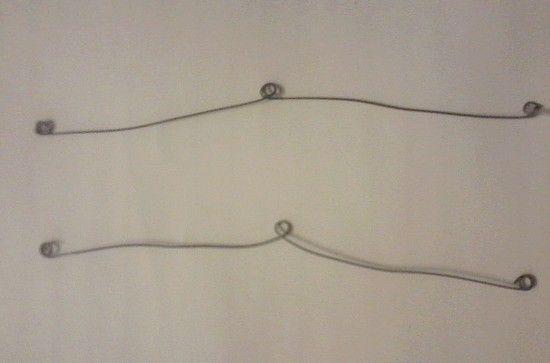
A simplified version of a do-it-yourself rocker arm
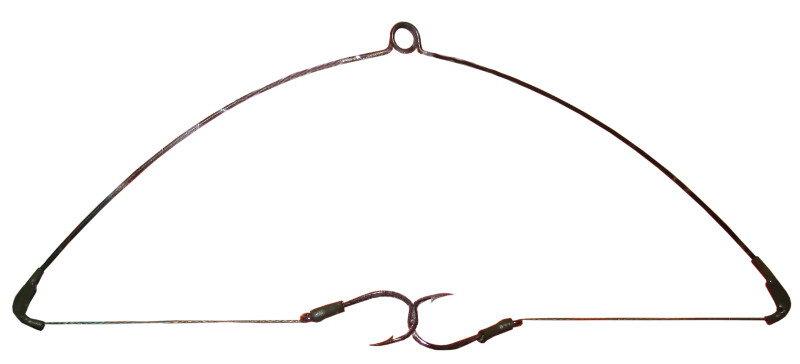
Tackle storage option

Leashes can be as small as 1 cm, but we recommend starting with two. There are several variations of the rocker , they differ in the material of manufacture:
- With sliding leashes . This bottom rig is positioned as the most sensitive, its leads are tied to the main thread through the end and central rings. When swallowing the bait, the bream does not feel any resistance and confidently pulls out the line. The bite signal is the float sinking and the nod bending towards the bottom.
- Blind equipment . The leashes are installed directly to the outer rings. When the bream begins to swallow the bait, one arm of the rig rises and the nod extends. A float placed on the surface of the water can also indicate a bite. Here it is very important to make the hook in a timely manner, otherwise the fish, feeling some resistance, may leave.
The success of ice fishing with a rocker depends on the correct manufacture of equipment and adherence to certain fishing techniques.
Video on how to make a rocker with your own hands
Fishing process
Hunting for bream in winter using a rocker is carried out at a depth of 7-15 m . First of all, they check channel dumps, holes, and coastal edges. The holes are drilled with a drill with a blade diameter of 200 mm . In order to avoid setting the bottom equipment by surprise when fishing, the fishing line should be kept closer to the edge when lifting the prey.
Catching bream on a yoke consists of the following steps:
- The bait is thrown into the drilled hole in half an hour using a feeder - a dump truck. It should deliver the mixture to the very bottom. In the absence of a current, it is enough to make a feed from several lumps of bait mixture thrown into the hole without a special device.
- Having put two types of bait on the hooks, make the first cast into the hole. Using the selection method, you will be able to determine the most advantageous bait option and settle on it.
- A straightened nod will indicate that the fish is trying the proposed bait; the hook is made when the arm of the bottom rig is lowered.
During the fishing process, it is recommended to use a hook.
Catching bream on a rocker, watch video
Fishing for bream in open water
Globally, two directions for catching bream in open water can be distinguished: using float and bottom gear. There are also all sorts of exotics, but we will talk about them a little later.
This fish is caught both from the shore and from a boat. In the first case, tackle with a longer rod length and spinning reels is used, providing a high casting range. The main thing in all cases is to prepare the most delicate equipment that will not alert the flat-bodied cunning fish, but at the same time will not break during fishing. The use of thin fluorocarbon or monofilament leashes is encouraged, as well as working with a drag when playing.
The gear is installed in maximum silence. The angler who can “hatch” the fish for hours wins.
Float rod
Shore fishing with a float rod can be considered effective only in cool water, when bream does not seek to escape the heat at significant depths. The golden time is spring and early autumn, and you can fish almost around the clock. It is better to walk through passive summer bream at dawn, dusk and at night. In a baited area at a considerable depth, you can catch a good trophy during the day, however, such water areas are usually accessible only from a boat.
Tackle
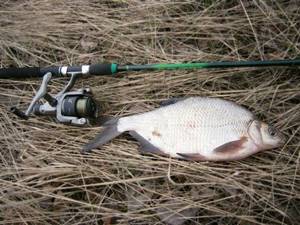
You can use a simple fly rod with the line tied directly to the tip, without a reel. The advantage of this option is the noiselessness and accuracy of casting: the equipment with bait goes into the water at a given point with virtually no splashing. However, even with the longest six-meter flywheel when fishing from the shore it is not always possible to achieve the desired casting distance. When fishing from a boat, you can take a shorter rod, since there is no need for extra-long casts.
An alternative option is a Bolognese or match rod with medium or medium-fast action. The reel is a spinning reel for 1000-2500 according to the Shimano classification (selected depending on the test of the rod for the bait and the required casting distance). The fishing line is a good monofilament with a diameter of 0.2-0.3 mm plus a twice as thin leash 15-20 cm long.
To catch bream, oval-shaped floats with an antenna are usually used. The carrying capacity ranges from 1-5 grams (the more active the fish and the strong current, the heavier the float). It is better to choose sinkers with the most streamlined shape, installing several pieces on the fishing line in increasing weight (at the bottom is the lightest weight).
It is rational to choose hooks No. 6-10 according to the domestic classification. The use of animal baits requires the use of hooks with the longest possible shank.
Fishing tactics
The main thing in this case is methodical feeding and maximum silence while fishing. The bait is placed directly on the bottom and they usually wait a long time for a bite. If the activity of small fish is high, the carrying capacity of the float and the size of the bait should be increased.
If bream is stubbornly not being caught, you can try increasing the length of the leader and playing with baits. In summer, this fish rarely grabs the bait indiscriminately: it carefully examines it for taste, therefore the protruding sting of the hook can scare it away.
Sometimes this fish is caught with a float rig and a wire. In this case, sliding equipment and maximum bottom cleanliness are required, otherwise snags are inevitable.
The classic bream bite involves moving the float to the side and then laying it out on the surface of the water. But options are also possible: each fish behaves individually. You need to hook immediately, but carefully: do not forget about the delicacy of the leash, which can simply break under the weight of a decent trophy.
Animal bait
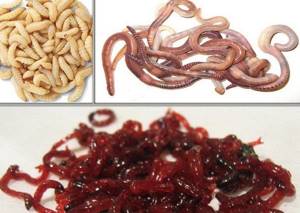
When catching bream, use such attachments of animal origin (bait) as:
- Bloodworm is a bright ruby colored mosquito larva, no more than 15-20 mm long. It lives in the bottom silt of standing reservoirs and swamps.
- Maggot is a mobile larva of a gray (meat) fly, white in color and up to 10-12 mm long. Maggot develops from eggs laid by flies on rotten fish and meat products.
- A dung worm is a representative of annelids with a brown-red body color and a length of up to 10 cm. It lives in old compost pits, under heaps of rotting plant debris.
- The crawl is a large worm of brown or dark red color. It lives under stumps, fallen trees and stones lying in damp places.
- This fish is less commonly caught using bark beetles, shitica, and burdock moth larvae (burdock).
Important. Of all the ones described above, the best bait for bream is bloodworm. Its catchability is explained by the fact that bright ruby worms are the constant food of bream.
The fish feed on worms and maggots much less frequently. Thus, bream can feast on worms when they fall from the shore with washed away soil. Maggot enters the diet of fish naturally, even more rarely from the carcasses of dead birds floating in the water. The disadvantage of this type of bream bait is its low vitality. So, in extreme heat or bitter cold, it quickly deteriorates and becomes unattractive to fish.
We recommend reading: Bait for bream in winter
Classic Russian donka
Bottom fishing is a more promising and all-season direction, but it requires more experience and fundamental preparation. In this way, bream is caught both from the shore and from a boat, but the first option is more popular.
Tackle
The basis of the tackle is either short telescopic rods or heavy rigid spinning rods up to 2.7 m long (you can use cheap “crocodiles”). The priority is casting range and reliability of the tackle; weight and sensitivity are not important.
The rods are equipped with spinning power reels of sizes 3000-6000 (Shimano) - depending on the fishing distance and the characteristics of the rod. You can also use classic inertial engines of the Neva type. As a fishing line, you can use a good monofilament with a diameter of up to 0.35 mm or a naturally colored braid of 0.16 mm. Hooks – No. 6-10 according to the domestic classification.
Traditional bells and bells, as well as modern electronic sensors, are used as signaling devices. Catching bream at night is greatly simplified by the use of light and sound alarms.
Feeders and installations
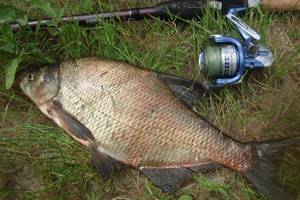
The equipment is, in principle, coarser than when fishing with a float: it has to deliver a large mass over a considerable distance. In most cases, all kinds of feeders are used: meshes, springs, methods. This solves the problem of bait delivery.
For Russian donoks, fixed equipment is typical (it increases the likelihood of self-hooking), but some fishermen also use sliding equipment. Anti-twisters are often used to separate the leashes and avoid them getting tangled.
In blind rigs (for example, on a rigidly fixed spring), you can tie leashes with hooks directly onto the feeders. You can attach leashes to the main line, on top and bottom of the feeder, through swivels or with simple knots - there are a lot of options.
Occasionally, bream are caught without feeders, using a sliding weight in the shape of an olive. However, this option is more relevant for fishing from a boat, when constant complementary feeding can be provided in other ways.
Fishing tactics
Donka is an example of passive tackle. The activity of the fisherman consists in carefully choosing a place, feeding, and accurately casting the tackle. Then he is actually free: he sits and waits for a bite. The gear is designed for self-hooking, so most experienced fishermen operate several rods at once. They are installed on all kinds of stands and rod-pods, making it possible to fix several fishing rods at once.
Kormaks are filled with food mixture, “imprinting” hooks with bait into them. To avoid entanglement, casting of gear is done using a fan. Ideally, gear is installed in the evening throughout the night and takes place in the morning, before the heat sets in. However, in cool spring or autumn water you can fish from the bottom around the clock: bream is active during these periods and does not so clearly strive to significant depths.
You should react to a bite quickly, but without unnecessary fuss: when self-hooking, bream does not leave the hook until it is reeled in, but it is quite capable of dragging the rod away. The main thing is to survive the first phase of fishing: as you approach the shore, the fish runs out of steam and does not resist so actively.
Catching attachment for catching trophy bream
In summer, trophy bream is caught well on the rivers using lard. But lard is not an independent bait, but works only in conjunction with a feeder filled with bait. Millet or pea porridge is usually used as bait.
This gear works as follows. Near the feeder there are short five-centimeter leashes with hooks (usually 2 leashes are used). Porridge is being filled into the feeder. This will be the main delicacy for the bream. Having found a feeder with porridge, he begins to eat the treat, and along with it he sucks in a piece of lard.
You can ask your question to our author:
Feeder
The English feeder (at least, it was invented in Foggy Albion) is a type of bottom tackle. It is somewhat different from the Russian donka both in equipment and in the technique of application. However, recommendations for choosing a place, bait and bait remain unchanged.
In general, the tackle is more delicate, tempo and tailored to specific fishing conditions.
Tackle
The choice of feeder is determined by the fishing distance, the characteristics of the reservoir (size, current strength) and the weight of the filled feed.
The most serious expense item is the fishing rod. It is better to take carbon blanks: they are lighter than fiberglass, which is especially important when fishing at a pace with the current, when there are often a series of casts with an interval of 5-7 minutes.
For fishing the waters of very large rivers, such as the Oka or Volga, heavy and super-heavy feeders are used, designed for long distances. The most common and universal option is the medium test, that is, the average one: it allows you to successfully fish in most of our reservoirs. Light pickers are used only on small rivers and when fishing from a boat, where there is no need for long casts.
It should be taken into account that when fishing for bream at long distances downstream, it is not uncommon to cast very heavy feed weighing 100-120 grams, which requires the use of extra-heavy rods. Opinions differ about the optimal rigidity of the blank: some prefer soft, slow rods, others prefer hard poles. An interesting option is a progressive system, when the inclusion of the blank in the work is determined by the amount of load on it: the whole rod works at maximum, only the tip works at minimum.
The reel is definitely a good power spinning reel. The mediums are equipped with reels with a capacity of 4000 Shimano. For powerful river feeders, six-thousand models are good; for pickers, two to three thousand sizes are usually sufficient. Pay special attention to the quality of the clip; a spare spool would also be a good idea.
Typically, cords with a diameter of 0.14-0.16 mm are used. Monofilament (diameter no less than 0.25-0.3 mm) is used less frequently: in weak currents and at very close distances. A breaking load of 10 kg is usually enough: bream is not as strong as carp. When long-distance casting of heavy rigs is necessary, shock leaders made of monofilament up to 0.3 mm in diameter or thicker than the main braid are often used.
Feeders and installations
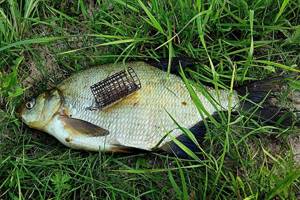
Feeder is a more sporting tackle than donka. All classic versions use cage-type feeders (square, round, triangular, “bullet”) with or without additional weighting. The size and number of holes is determined by the strength of the current.
Almost any of the popular feeder rigs can be adapted for bream fishing. For beginners, we can recommend something simple like a paternoster (two branches are formed on the main line - for a feeder and a leash with a hook) or a classic sliding inline (the feeder on a swivel slides freely along the line up to the limiter beads).
Leashes made of thin monofilament (0.12-0.14 mm) are used long, from 30 cm to one and a half meters, depending on the degree of activity of the fish. The hooks are smaller than in classic bottom fishing.
Fishing tactics
First you need to master casting properly. We are talking about heavy installations and a rather delicate form that can be easily damaged if handled improperly. It is necessary in every possible way to avoid being caught by the “tulip” and at first not to go beyond the test form. And here the accuracy of casting is also fundamentally important!
After casting, the feeders are installed on the shore, usually parallel to the water. The fisherman monitors the behavior of the quivertip (sensitive tip), ready to react to a bream bite.
Feeder fishing is quite dynamic. The feeder constantly adapts to the fishing conditions, changing the length and thickness of the leashes, the size of the hook, the configuration of the feeder, and so on. Therefore, when using a feeder in the classic version (without additional alarms, with feeder feeders), the fisherman rarely serves more than two gears.
When catching and playing bream (as well as other large fish), the correct setting of the clutch is extremely important. Only competent use of the friction brake, coupled with the individual skill of the fisherman, allows you to pump out powerful fish on delicate equipment.
Common fishing methods
Methods and equipment for winter bream fishing can be different - it all depends on fishing conditions, skills and personal preferences. Let's look at the most popular options, highlighting their characteristic features.
Fishing with a float rod
Winter fishing rod PROFI UP-3 with plastic.
handle Three whales 48 for 1 piece. Winter fishing rod Pier 68-Pl. Pier Master 110 for 1 piece. Angler's set for winter fishing No. 3 Three whales 279 for 1 piece. Winter fishing rod Pier 50-B PIRS 79 for 1 piece. Winter fishing rod UD-1 with a semi-detached handle Three whales 52 for 1 piece. Winter fishing rod Pier 55-C PIRS 79 for 1 piece. Winter fishing rod Pier 55-M PIRS 68 for 1 piece. Winter fishing rod WH 56P L200 Pier Master 150 for 1 piece. Winter fishing rod Pier 55-B ABC PIRS 103 for 1 piece. Winter fishing rod WH 56P L250 Pier Master 237 for 1 piece. All winter fishing rods in the catalog
The most commonly used method, whose popularity is due to its versatility. You can use a winter fishing rod with a float at any depth and current; its performance is not affected by either wind force or air temperature. However, such fishing will be effective only with the correct selection of gear. The main rule is a clear weight balance between the sinker-hook connection and the float. It is necessary to strive for a ratio in which the weight of the bundle is slightly greater than the carrying capacity of the float. The latter should not sink sharply, but smoothly - otherwise the bream, feeling resistance, will immediately spit out the hook with bait.
Turned winter double float No. 1 yellow Premier Fishing 58 for 1 pc. Float type 1 (8954245) Three whales 6 for 1 piece. Turned winter single float No. 1 white Premier Fishing 37 for 1 pc. Turned winter double float No. 2 yellow Premier Fishing 58 for 1 pc. Turned winter double float No. 2 white Premier Fishing 58 for 1 pc. Large tablet float (8953537) Three whales 7 for 1 piece. Turned winter single float No. 1 yellow Premier Fishing 37 for 1 pc. Float winter type Small tablet Tayur 7 for 1 piece. Turned winter double float No. 3 yellow Premier Fishing 58 for 1 pc. Float type 0.75 Three whales 5 for 1 piece.
Choose a winter float
The following components are suitable for assembling a winter bream fishing rod:
- rod with a standard length whip;
- open coil design;
- monofilament fishing line with a thickness of 0.14-0.16 mm - it’s better to take a dark one, it will be more noticeable in the snow;
- one or two hooks No. 10-12, however, for catching large fish, the hook size can be reduced to 14-16;
- IMPORTANT: choose hooks with a long shank - on it you can attach a “sandwich” of several types of bait, which will be more attractive to bream.
- a regular or composite float with a carrying capacity suitable for specific fishing conditions;
- sinker - it is better to place several small pellets than one large one.
Dacron gatehouse 350 microns/13 cm, 0.8 g Left-hander-NN 67 for 1 pc.
Gatehouse PM Dragonfly SCHP-L No. 2 Pier Master 70 for 1 pc. Dacron double nod on silicone NOD S-LS15 (140 mm, hardness 0.35) Helios 45 for 1 pc. Dacron nod on silicone NOD S-LS07 (80 mm, hardness 0.20) (S-LS072008 Helios 35 for 1 pc. Dacron double nod on silicone NOD S-LS16 (120 mm, hardness 0.35) Helios 45 for 1 pc. . Conical gatehouse No. 5KCH (03-3.5 g) PIRS 49 for 1 pc. Double lavsan nod on silicone NOD S-LS101 (110mm. hardness 0.50) (S- Helios 64 for 1 pc. Mosquito nose nod Mini 80 mm (350/1.45 – 3 g) 5 pcs/pack Fisherman's talisman 363 for 1 pack PM lavsan guard T 45-140-12 Pier Master 30 for 1 pc PM lavsan guard Bream-T 40-185-50 Pier Master 45 for 1 piece Select a nod for a winter fishing rod
When fishing with a float tackle, bream should be hooked when the bite alarm goes into the water or rises back.
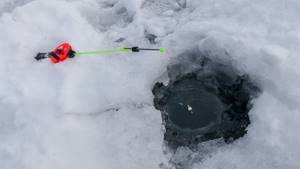
The hook should be confident, but not overly strong - bream has thin lips that can easily be torn by a hook.
Catching bream with a jig
Winter sports fishing rod Balalaika US-2 Three whales 48 for 1 piece.
Winter fishing rod (balalaika) (Winter 1) Tonar 74 for 1 piece. Winter fishing rod. RBUZ green fiberglass whip (RBUZ-G) Helios 300 for 1 pc. Winter fishing rod. SPZ red fiberglass whip (SPZ-R) Helios 285 for 1 pc. Winter fishing rod. RBUZ yellow fiberglass whip (RBUZ-Y) Helios 300 for 1 pc. Winter fishing rod. SPZ green fiberglass whip (SPZ-G) Helios 285 for 1 pc. Fishing rod winter filly North, 340 mm, 117230 AQUA 70 for 1 piece. Winter balalaika fishing rod Ice Ecorod 01 yellow 25 cm Salmo 85 for 1 pc. Winter fishing rod. STFS yellow (STFS-Y) Helios 193 for 1 piece. Winter fishing rod. STFS green (STFS-G) Helios 193 for 1 piece. All winter fishing rods in the catalog
Another popular fishing method that shows good results even during periods of deep winter. The main task of a jig when catching bream with it is to deliver the bait to the bottom of the reservoir. However, it also attracts the attention of fish quite well. The color of baits can be different, mostly fishermen use silver and black options; it is better to select them yourself for a specific body of water. Different shapes are also suitable - you can experiment with all the options from pellets to nail guns and flies. The hook should be large enough to easily attach several bloodworms at once.
Recommendations for completing jig tackle:
- light and sensitive fishing rod 18-30 cm long;
- a nod of medium hardness, the length of which should be chosen in the range from 7 to 16 cm - in particular, you can use a clock spring or a lovsan nod, which, due to its rigidity, can ensure self-hooking of pecked fish;
- reel of reliable design;
- monofilament line with a diameter of 0.1-0.17 mm, about 20 m long
- a heavy jig that can quickly deliver a bloodworm or jig to the bottom of a reservoir.
Jig Nailball black banana, cheese cube Premier Fishing 69 for 1 pc.
Jig Cat's eye 0.58g suspension d2.0 yellow Premier Fishing 67 for 1 pc. Jig Nailball black banana, chameleon cube Premier Fishing 69 for 1 pc. Jig Gvozdesharik green, multi-faceted hamel ball Premier Fishing 69 for 1 pc. Jig Cat's eye 0.58g suspension d2.0 green Premier Fishing 67 for 1 pc. Mormyshka Garlic with hole. goat 3mm 0.63g (MW-K1530-Go) Helios 61 for 1 pc. Mormyshka Ant gran. with hole. 4mm 1.03g (MWC-K3440-Sil) Helios 89 for 1 pc. Mormyshka Maggot with eye color. 135-1 Helios 83 for 1 piece. Cast jig Garlic Small No. 15 0.4g. (X) PIERCE 16 for 1 piece. Choose a suitable jig
When fishing with a jig, you need to be prepared for the fact that you will have to actively search for bream throughout the reservoir. Having reached the chosen place, drill a hole, throw in a starting portion of bait, and then lower the jig into the hole. Without sudden movements, lay it on the bottom, then briefly lift it up several times - the jig should tap on the bottom. When lifting the bait, the nod should swing smoothly, without jerking. You can determine the moment to hook by the position of the nod. If it rises up, it’s time to hook.
Bream on jigs work better in reservoirs with stagnant or weakly flowing water. For fast-moving rivers it is better to use a winter feeder.
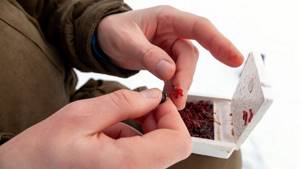
Fishing for bream on the devil
A little devil equipped with three hooks is perhaps the main tool for fishing for this fish. The fact that bream like it is confirmed by the experience of several generations of fishermen. The most catchy options have an elongated narrow body from 1 to 2 cm.
The body is most often painted black, green or red. To make the devil even more attractive to fish, cambrics or beads can be added to the hooks. But there should not be a lot of it, otherwise there is a risk of scaring off the cautious bream. Therefore, just a few beads of contrasting colors are enough.
Tungsten jig Devil with cube Chameleon Premier Fishing 49 for 1 pc. Jig tungsten Chertik tee with hole. and beads. 3mm 0.67g Bn (MW-3030-Bn) Helios 95 for 1 pc. Jig ChM hook HAYABUSA Y.CHK 128 Tula 188 for 1 pc. Tungsten jig Devil triangular with a ring 2mm 0.43g Cu (MW-3220-Cu) Helios 89 for 1 pc. Wolf jig.Devil with hanging tee with fly 3mm 0.85g Sil,MW-5430TF-Sil Helios 150 for 1 piece. Jig tungsten Chertik tee with hole. and beads. 3mm 0.67g Ni (MW-3030-Ni) Helios 95 for 1 pc. Tungsten jig Devil triangular with a ring 2mm 0.43g Sil (MW-3220-Sil) Helios 89 for 1 pc. Devil with hanging hook Spider-Doll 0.4g (Z) PIER 59 for 1 piece. Tungsten jig CHERTIK with loops. Lucky John 030/10 (824030-10) Salmo 68 for 1 piece.
Winter devils in assortment
Catching bream with a “Devil” type reelless reel requires a balanced ratio of the mass of the bait and the rigidity of the nod. You need to play the devil with a large amplitude, but without sudden movements. The movement of the bait is from the bottom up and back. Choose the height to which the bait can be raised taking into account the activity of the fish. If the bream is active, then it can follow the devil and almost to the very surface. During periods of calm, it is better to concentrate on the bottom water column.
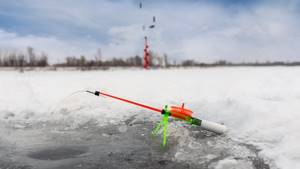
Summer jig
Sometimes passive summer bream goes well on a jig with a dung worm, maggot, or even well-prepared pearl barley. For this option, light, sensitive rods with a small test are used: jig fishing requires the active participation of the angler.
The most promising direction is to use a small fishing rod or ultralight spinning rod when fishing from a boat. However, in some cases, wading fishing or catching bream from bridges and steep banks, where casting to significant depths is possible with a short rod length, is also quite effective.
When mormyshing, fairly thin but high-quality monofilament threads with a breaking load of at least 5 kg are used (larger bream is extremely rare). Jigs are larger than those used for winter fishing. When fishing at night, luminous jigs are sometimes useful, but cautious fish may be frightened by an unusual “firefly”.
The game consists of lowering the jig to the bottom and lifting it up (it’s good if at this moment the current makes it tremble a little). The animation technique will have to be constantly varied: sometimes bream like aggressive play, sometimes delicate play, with long pauses. In some cases, the jig is used passively, as an element of float equipment.
How to catch bream using a ring
One of the most original and catchy gear is the “ring”. In this way, decent bream are caught from hydraulic structures, but more often the tackle with a ring is cast from a boat.
To create the tackle, you need a metal ring-weight with a diameter of 55-65 mm and a thickness of 3-5 mm. It must be put on a thick fishing line (at least 1 mm in diameter) or a cord (for this, a hole is made in the side of the ring or an eye is soldered on). Sometimes a cut is made in the ring so that it can be quickly unhooked from the cord with the feeder.
So, we have a ring through the eye of which we thread a cord and secure the whole thing with a stop bead. At the end we attach a swivel, to which we will subsequently attach a long leash (1-2 m) with a hook (as for a donkey).
A cord is lowered from the boat to the bottom, on which there is a feeding bag with a mixture of a fairly loose consistency (so that it “dusts”). The cord must be passed through the ring and secured to the side of the boat.
A cord with a ring is mounted on a light short spinning rod or a fishing rod, and bait is attached to the hook. The bag with the feed mixture “gathers dust”, ensuring constant attachment of fish. The fishing rod is cast against the current, the cord with a ring is connected to the bait net. The leash is pulled downstream along the formed feeding path.
In Soviet times, ring fishing was prohibited; now, to the delight of experienced bream fishermen, it is not included in the list of poaching fishing methods. In a word, fish to your health!
Biting and fishing

Bream is a large and quite strong fish. She offers especially fierce resistance in the first meters of fishing. The main thing is not to miss the bite (it’s difficult to hesitate, unless you openly “yawn”) and carefully hook the fish. There is no need to pull sharply: you can tear off the thin leash or simply deprive the bream of its lips - it will leave crippled, but not defeated.
The greatest opportunities for catching large specimens are provided by a spinning reel with a correctly adjusted clutch. It is best to adjust it to the maximum according to the leash test.
The fish must be “pumped out”, gradually depriving it of strength and desire to fight: let it go a little, lowering the rod, and gradually pull it up, reeling in the fishing line. Ideally, in the final stage, you need to lay the caught bream on its side (with its flat body this is relatively easy) and lift the fish’s head above the water so that it catches air. Near the very shore, you should carefully place a landing net under the exhausted trophy, and it is better if a friend sitting next to you helps with this. Operating a rod with fine equipment and a landing net at the same time is quite difficult - you need an experienced hand.
Features of ice fishing
As mentioned above, it is problematic to catch trophy bream at the end of autumn, and in winter the chances of catching it are close to zero. However, this is not tragic: a truly large specimen with a characteristic flat body simply will not fit into a standard hole.
During thaw periods, you can catch small bream (up to a kilogram in weight, that is, bream), but truly enviable specimens become active only in the spring, with the influx of melt water. However, winter bream fishing is a separate area in which some experienced fishermen specialize.
This fish is caught mainly near wintering pits, from which it periodically comes out for short-term feeding. It is important not to miss this short period, identify a promising place and properly attach the fish.
Fishing with winter gear
The main gear used is predominantly a light winter fishing rod. Sometimes it is equipped with a lightweight inertial reel, which makes fishing easier, but you can get by with a primitive reel. The fishing line is strong, but not noticeable in the water. Ideally, it is better to use winter fluorocarbon - it is practically indistinguishable in water. If the equipment is based on monofilament, we focus on diameters of 0.15-0.18 mm.
Massive pre-feeding is important. The basis of the mixture is bloodworms or jigs, to which canned corn, cereal grains, and cakes are added. You can add a little more attractant: in cold water the aromas do not spread as intensely. The bait is delivered directly to the bottom using special self-expanding winter feeders.
You can catch sleepy winter bream either passively or using active gear - it all depends on the preferences of the angler. The main thing is to maintain silence: bream is very shy, and even careful steps on the ice can scare it away from the feeding point, not to mention drilling a hole. And don’t forget to bring a hook with you to retrieve trophies from the water!
Float equipment
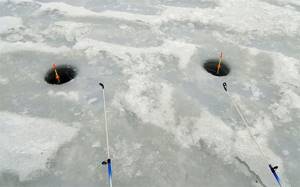
Here is an interesting option that does not require expensive equipment. They take a light fishing rod with a reel and a supply of fishing line of 20-25 m. Fishing is carried out at great depths (sometimes about 10 m), and the bait is delivered to the bottom. Silty areas are promising, where there are often huge numbers of swarming bloodworms. This rustling sound, inaudible to the human ear, attracts fish from afar.
In winter fishing, light miniature floats are used. They are surrounded in such a way as to achieve a perfectly vertical position. In severe frosts, when freezing of the hole is inevitable, the float is sunk by weights by 2-3 cm.
Ideally, the lower stock should lie on the bottom, and the bait (usually a bloodworm or maggot) should be located slightly away from it and sway with the movement of water masses.
The fishing rod is usually not held in hands, but placed on a stand near the hole. When biting, the float either sinks slightly and moves to the side, or lies down. Fishing is done using a reel - choosing a fishing line with a decent specimen resting on it by hand is quite problematic.
Rocker
The basis of the “rocker” is a light winter fishing rod with a fairly rigid nod. You can also use a float with a carrying capacity selected according to the weight of the gear. Baits are taken as in the previous case - mainly bloodworms (always live!) or maggots.
Actually, the tackle, which can be used to catch bream even in “non-biting” winter weather, is a “yoke” made of rigid steel wire, a durable plastic tube or a piece of cable insulation.
In the first case, a fixed rig is created: leashes 5-7 cm long with hooks are tightly tied to the ends of the rocker. When using a hollow tube, you can make a slip rig by passing a leader through the tube, securing it with beads and tying hooks on both ends. The main line is tied exactly in the center, where the weight that balances the rocker is located.
When there is a bite, one of the arms of the yoke rises, which signals the need for an urgent hook.
Mormyshka
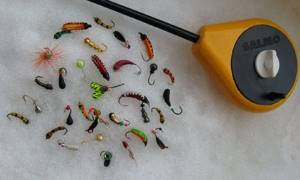
Here is a classic of the genre, invented by Russian fishermen - yes, the jig was invented by our compatriots. This bait is a drop-shaped, pear-shaped, round or other shaped weight with a hook at the end. It imitates the amphipod crustacean, one of the most important items on the winter diet menu for representatives of freshwater ichthyofauna.
Bream are caught with a jig in different ways: a bait with a bloodworm attached can be used as a component of a float rig, with a nod “to the riser” or with active animation. Jigs without refills (reelless jigs) require mandatory “revitalization” by the hand of an experienced and persistent fisherman. It is important to choose the right pace of jerking and tapping, alternating pauses with periods of play, and this can only be achieved through experience.
Garland
Imagine a fishing line with jigs tied to it on personal leashes - this will be a garland. They fish with it at considerable depths, covering several horizons with one cast.
For mounting a garland, jigs of the “Uralochka” type with a diameter of about 2 mm are ideal. The leashes are attached to the main line at intervals of 20-50 cm, through a swivel with limiter beads or regular knots. The fishing rod is an ordinary winter one, with a flat metal nod. Fishing with a garland is effective only in small currents or in still water, otherwise the tackle will get tangled.
Ride
Roll fishing is one of the active methods of winter fishing. Mostly small bream and large roach are caught this way, but perch can also be caught. Fishing is only possible along the current, that is, on the river.
To equip you will need a fishing rod that is strong enough and long by winter standards (50-120 cm) with guide rings. Ideally, the rod is equipped with a large-diameter inertial reel of the Neva type - this will make it easier to reel in the fishing line. An olive weight is attached to the main line, then, through a stop bead and a swivel, a leash with a hook. The bait is standard - bloodworms, maggots, flour beetle larva.
The fishing technique is reminiscent of playing with a jig, although the vibrations are less frequent and more amplitude. Or you can rewind the line and release the sinker (sinker) with the flow, periodically raising the tip of the rod and pulling the load towards you.
Helicopter
The “helicopter” tackle is aimed at passive fishing (with a riser). Holes are drilled at some distance from each other and several gears are installed. The main thing is to make sure that the bream does not drag them into the hole.
The basis is the simplest winter fishing rods with flexible guards. A pyramid weight weighing 30-40 (sometimes more) grams is attached to the main line through a swivel. A leash with 3-4 hooks is tied to its ear, and all this splendor is crowned by the “helicopter” itself - a tin structure reminiscent of a monolithic block of paper clips for a stapler.
This tackle was invented specifically for catching bream and other whitefish in large rivers - it is the current that gives it a seductive rotation.
Harvester
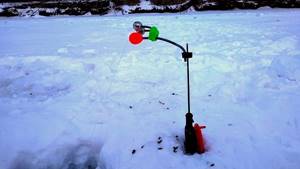
A combine (or descender) is another passive equipment for winter fishing for large white fish on large rivers and significant depths. As in the case of a helicopter, the current is responsible for the animation of the baits.
The requirements for a fishing rod, fishing line and hooks are the same as in the previous case, that is, none. The tackle is designed for self-hooking, so a particularly sensitive nod is not needed, but a bright colored signaling tip would not hurt.
The gear is equipped like a combine harvester, but the weight is a cage-type bottom feeder, and hooks with bait are attached to separate leashes.
Ring
We have already mentioned catching bream with a ring above, in the section devoted to summer fishing. A similar method can be used in winter, but a boat is no longer needed, which expands the possibilities of fishermen.
The principle of fishing is similar to the summer version, the only difference being that the cord with the feeder is attached to a separate rod (however, any stick can be used for this). The working gear is installed permanently and is equipped with a guard. As with all passive types of fishing, it is possible to operate several gears.
Bream is a cautious fish
One of the main rules of ice fishing for bream is the need to remain quiet. And not only during the actual fishing. It is also not recommended to rattle the feeder; the fish may get scared and run away to a quieter place. In large schools, the leaders - adult and strong fish - are responsible for caution. If he has even the slightest sense of danger, he will not lead the flock into such a section of the reservoir.
Silence must be observed especially strictly in “wild” bodies of water, where fishermen rarely visit. In habitable places, the fish gradually gets used to some extraneous sounds, and it begins to behave more boldly. In poorly fished rivers and lakes, any unfamiliar sound will cause her anxiety. Therefore, it is recommended to place a soft soundproofing lining even under the fishing box to prevent the plastic from squeaking on the ice.
Excessively large gear can also spook the fish. Therefore, you should not mount the largest available bait on your fishing rod. Also avoid sharp transitions from light to shadow, so position yourself near the hole so that it is not obscured by your movements. An excellent option would be to catch bream in winter in a tent - it will block the hole from sunlight, so when you bend over, you will not shade it too much. In addition, fishing in a tent is much more comfortable; it will protect you from both wind and snow. The temperature in a closed dome will also be higher.

Ready-made groundbait Formula Winter Ready 0.5 kg (SUPER BETAINE-WINTER) ALLVEGA 95 for 1 pack. Aroma gel spray MIX 397 Perch (1 fl.-50 ml) (PDZ-006) PELICAN 206 for 1 pc. Winter bait moistened ICE Bream Red (1 pack - 500g.) (IC-002) 100 BITS 134 per 1 piece. Liquid sponge cake 402 with glitter 500 ml (PB-002) PELICAN 182 for 1 pc. Mega Strike Original universal attractant, gel, 28g (MS-02-1oz) Mega Strike 720 for 1 pack. Prepared bait Formula Winter Ready 0.5 kg winter bream ALLVEGA 95 for 1 pack. Winter bait moistened ICE Bloodworm (1 pack - 500 g.) (IC-008) 100 BITS 134 per 1 piece. Winter bait moistened Roach (1 pack - 500 g.) (PE-026) PELICAN 170 for 1 pc. Ready winter bait Formula Winter Ready 0.9 kg (SUPER BETAINE) ALLVEGA 150 per 1 pack. Winter bite activator. PELICAN Bloodworm (PE-045) PELICAN 242 for 1 pc.
The most delicious baits to choose from
Tips for beginning bream climbers
At the end of our extensive publication, I would like to give some advice to beginning bream climbers:
- Prepare your gear carefully. In this case, 50% of success depends on the preparation of gear. The remaining 50% can be given to a serious approach to choosing a fishing spot and proper attachment.
- Do not make noise. It is difficult to find such a wary fish as bream. The slightest noise can ruin many days of preparatory work. This is especially true for those who want to hunt bream on ice.
- Be patient. Catching trophy bream is the lot of the most experienced and patient, who are ready to sit for hours waiting for a single bite. Hunting for this fish and vanity are incompatible!
We wish you enviable trophies and a landing net at hand, dear fellow hobbyists!
Fishermen wonder why I’m biting and they’re not?
I’m revealing a secret just for you: it’s all about the miracle bait! More details

